Agra Indian Hospital QAIMNS World War Two
Part 5 of the War Diary of QAIMNS Matron Hughes which saw her take up duties at Agra Indian Hospital during World War Two where she nursed cholera patients and learn to use the Tommy gun and service revolver
Read part four on the Aden to Bombay World War Two QAIMNS Diary page.
One evening orders came through for me to take up temporary duties at the Indian hospital in Agra. I said farewell to my unit, and felt sad leaving them after what we had been through together. My journey took forty-eight hours. A special coach was put on a train for me, with seats that could be put down for sleeping on, and I carried my own rations. At this time it was rather difficult, not knowing Hindustani and my Arabic being of no use in this country. The journey took me through all sorts of places, over viaducts, climbing fairly steep mountains with the engine puffing away. When the train slowed down in the jungles, monkeys climbed on to the carriage roofs, and water buffaloes could be seen up to their necks in filthy jungle slime.
After a non-stop run, and feeling dirty, tired and hungry, I arrived at Agra and was met by the matron of the Indian hospital complete with a personal bearer (servant) who collected my kit, and a tongo with a very nice-looking white horse whose name was Musti, and the driver, Busti, dressed in his white shirt and turban.
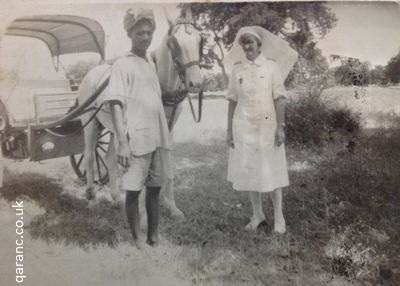
He turned out to be a very loyal man. The journey from the station to the sisters' mess was two miles. The mess stood in a lovely garden surrounded by large banyan trees which at night would be covered with parakeets making a terrible noise, then during the day by monkeys who, if they got into your room, would play havoc with everything. The servants lived in mud huts within a short distance of the mess. The hospital, one and a half miles away, was a low flat building, all stone, including the floors, so that in the heat of the day water could be sprayed around. My bearer engaged his own staff which consisted of lower race, one sweeper who did all the dirty work but would not touch water, and the other a besti who did all the water carrying. The type of work they do has something to do with race and religion. The bearer himself was important, giving orders and looking after my personal belongings. Looking after a Baua Mem Sahib was considered a great responsibility. At this time the War Office had granted the Queen Alexandra Sisters a commissioned rank of officers, mine being that of Captain.
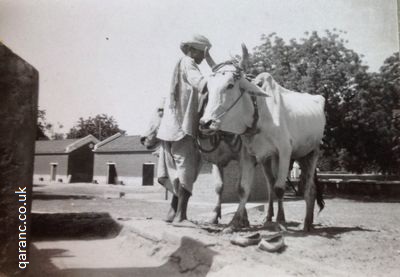
Agra is situated on a plain, and in ordinary times the regular troops families always go up into the hills during the hot season, but by now they had all been evacuated to the United Kingdom because preparations were being made on active service lines. I had been sent here to turn the Indian hospital into a combined British and Indian one. Troops began to arrive from Hong Kong and Singapore. To help train and recruit the Indians for active service the hospital was to be extended, with X-Ray and operating theatre. I spent a very busy time. The Colonel and his medical officers were all Indians and had been running things their way. At first they resented being told anything because, really, the men never look up to women, but they were soon re-educated and began to be quite co-operative. Eventually British medical officers came along and this made it much easier.
They had several cases of cholera, these, of course, being in a hut apart. Having made no previous contact with a case, I was anxious to investigate. I was horrified at the conditions in which they were being looked after, with no proper nursing. The native is so terrified of the disease and no one is expected to survive, that they just left them, but this was soon put into proper order. Sepoys (nursing orderlies) were detailed to the sick bay, taught to put on masks, overalls and gloves, and to use plenty of disinfectant. The ward was thoroughly cleaned up and ventilated and a special cook put in to make the feeds. In the end the sepoys quite enjoyed the work. They were changed every two weeks, but the disease did not look so terrifying to them afterwards. They all had cholera injections and I think this gave them a lot of confidence. After getting everything settled I began to give lectures in training for field ambulance work and duties, also nursing and first aid. They took the work very seriously and were very good at grasping things. I was amazed how quickly they learned, but as the Indian has a one-track mind, once they have been taught a thing you must not change it.
I collected some better educated men for duties in the operating theatre. Watching a few operations being performed by the Indian surgeons at this time was an eye-opener, their methods being crude and not very hygienic. They had only been operating on their own people. This had to be reorganised when the British boys began to be admitted. A British surgeon and medical officer were appointed and things were very different. An autoclave and steriliser was installed, a new theatre hut built and the sepoys taught how to work them. Little did these boys know that in the very near future they would be drafted to active service. It was pathetic to see them trying to walk in Army boots as they had never worn boots before in their lives. Then the uniform! But they felt proud, and when off duty would walk around the villages showing themselves off. This, however, proved a good recruiting stunt and as were inundated with offers of service the unit began to grow. The Indian is a grand fellow, but at heart he is like a child. He will be lead but not bullied, and mixing and working with the British was good for them.
In my tonga when off duty I began to look around. My first visit was to the wonderful Taj Mahal, a massive building built of pure white and black marble with walls and floors of beautifully coloured mosaic. Seen by moonlight from the entrance gates half a mile away it is a sight never to be forgotten, with its paths of marble and lily ponds leading up to it, the rose gardens and banyan trees hanging so gracefully. These trees have their roots on the top, making them look as if they are growing upside down. The view from the small windows and on the flat roof takes in the jungle for miles, also the rivers Ganges and Jamnu. When people of a certain race and religion are buried, they build a pyre near the Ganges, place the body on it and pour oil over it. The pyre is then set alight and the ashes thrown into the river. In one case I saw a body being taken on a stretcher and slipped into the river, to be carried away by huge turtles. The relatives and friends always sing and dance around the pyre when a body is being burnt.
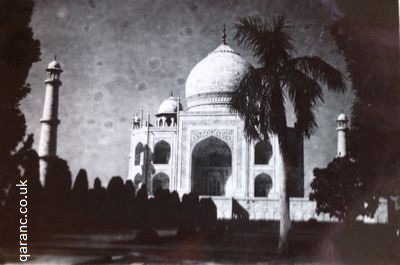
Back to the palace. It has a large dome of pearl marble and in this dome a tomb of the Mumtag Mahal, who was the Empress. The Emperor's tomb is in the dungeon with other members of the family. Both tombs are very richly inlaid with costly jewels and stones beautifully cut and attractively designed and highly polished. On special festive seasons this place is visited by pilgrims from all over the world. The Pearl Mosque, as it is called, was built at a cost of three lacks of rupees in the year 1654, the marble measuring 187 by 243 feet, giving accommodation to about one thousand men to pray, and on each side are chambers for the females to worship - they don't mix in prayer. The gardens are beautifully kept, the grape vines hanging thickly with luscious black grapes.
Near the palace is the great Delhi Fort, built of red brick. This was taken over by the military authorities to accommodate the whole population of Agra should the enemy invade. It had massive underground rooms and cellars. The larger room had been portioned off to separate the British civilians from the Indians. I believe that during this time they were expecting the enemy to land as they were quite near, but everything was kept secret in case of panic. The QA Sisters at this time had been taught to use the service revolver, rifle and Tommy guns on the range in case of trouble.
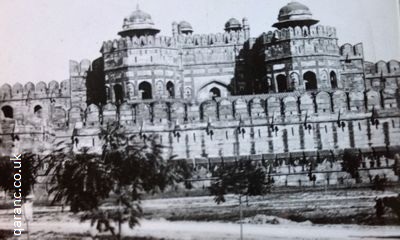
Monkeys large and small walked about this area quite freely both in the gardens and on the roads. No one took any notice of them, father and mother holding the hands of the small ones. They were very impudent at times and looked on us with suspicion. The monkeys are awful thieves and are very destructive when things go wrong. On one occasion a sister left a bowl of bananas in her room and on two days they disappeared. She blamed her bearer, who told her it was the monkeys. She did not believe him in spite of being told that they came through her roof fanlight. So one day they arrived and there was no fruit. A partly-knitted cardigan lay on the bed, so they took it and ran up and down the trees until there was no knitting left. When told, she went out to look. They were waiting for her and just laughed.
Bullocks drinking water from a well, the tree was full of baby monkeys:
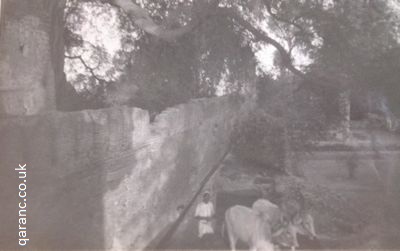
One day a party of us went for a picnic along the new Delhi road. Alongside, many miles out of Agra, was a large dam and reservoir, the water beautifully clean and clear, but full of large and small crocodiles, huge fellows sunning themselves on the banks and babies swimming around in the water. They looked very pretty, their colours showing up in the sunshine. This place was surrounded by wild jungle and we thought it a nice place to have our tea, so instructed the two bearers and the car driver to lay it out. The cook had made us some lovely meat pies, cake and rolls, with lemonade and lumps of ice which had been taken in special flasks. Being fascinated watching the crocodiles, we forgot the time. The bearers had been calling to let us know the meal was ready but, receiving no answer, thought they had better look for us. They forgot to watch over the food, so when we eventually returned there was only the tablecloth on the ground, all the eatables having disappeared, but up in the trees a party was going on of monkeys enjoying our tea. The bearers swore and threatened them with everything under the sun, but all they got back was laughing and chatting. Needless to say we had to go without. The bearers were in disgrace and very frightened in case they were punished. They were thinking only of our safety because this part of the jungle had wild beasts and snakes.
Snakes of various species are found in Agra. Every day one would try to find its way into the wards, but the Indians are experts at killing them. On one occasion a servant going to get a morning bath ready for his Mem Sahib found one coiled up in the bath. The baths, of course, were of ordinary tin. A mongoose always hunts snakes, so when these little fellows were seen prowling around it was a warning, as they could smell them. The troops used to make pets of them, even buying collars and chains to lead them by. They would often be seen on their shoulders when out walking. Scorpions would find their way into the beds and the insides of shoes so everyone was warned to look well into the bed and to shake their shoes before putting them on. Mosquitoes and biting flies would start flying around and nipping at sunset, so all nets had to be fixed on the beds before this hour.
One afternoon it suddenly went dark and looked as if a storm was coming up over the plain. The next thing was panic and great excitement, all the natives running from the huts. Fires were started in the surrounding fields and in the hospital grounds. It turned out to be an invasion of locusts, the idea of the fires being to prevent them from settling down. They are the most dreaded insect in the East. Wherever they stop, everything is eaten up, the place stripped of all greenstuff, trees left leafless, these creatures causing famine. They are roughly six to eight inches in length with fat yellow bodies, and make a roaring, buzzing sound. It was an amazing sight. The people managed to drive them off, although quite a lot of damage was done. Thousands landed on the ground, the natives collecting them, pulling off the wings and eating them. I believe they are considered a great delicacy. It was only on rare occasions that locusts visited the plain. I was thrilled to have had the opportunity of seeing such a sight.
India is noted for its minarets and mausoleums, all built of marble and stone. All the palaces belonged to the Akbai, who was the Indian ruler many years ago. The palace in the grounds of Sikundra were surrounded by well-kept gardens and high walls and looked out over the river Ganges and jungle. Here again the grounds were a playground for the monkeys, some being huge fellows. They would sit on the walls watching all that went on, and they did not like to see strangers. The marleys (gardeners) kept them under observation when we looked around the place.
Akbar’s Palace India built in marble 1941:
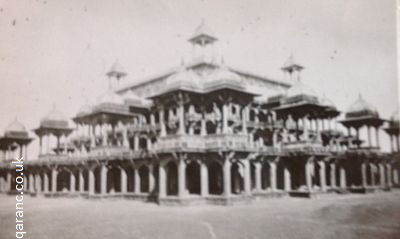
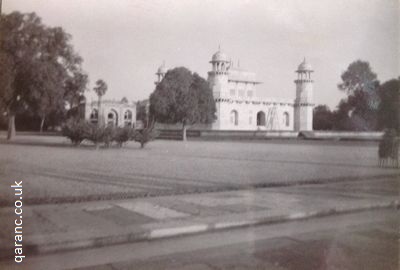
Another palace at Natshui Siki was built of red Indian stone and belonged at one time to the Akbai. It was on the top of a very steep hill and is the highest gateway in the world, being 176ft high from the road below and 134ft from the pavement in the front gate entrance. The palace was built in the year 1602 by the Akbai to commemorate his victory in Deccun, and situated so that he could see most of his territory. On the road to the gateway was a pond where native children would dive several feet into the water for coins which they picked up out of the water. The palace, though more or less in ruins, was being used for the grazing of cattle, shepherds using the buildings for shelters and watching over their flocks. Troops also used a part for billeting and training, it being many miles from any village.
During September 1940 a mild epidemic of cholera broke out. All the staff received serum injections, and for forty-eight hours the after effects were terrible. When our hospital was rearranged three separate kitchens had to be built - British, Moslem and Hindu - and cooks found to run them. The Indian is a good cook and I got quite used to their food and curries.
A journey to Poona across the great Bore Ghant was like riding on a switchback railway at times. The mountain ranges were, in places, very steep, being roughly sixteen miles, with about eight viaducts to cross. The climate here was cooler. The river Bore Ghant is used by the Hindus for burying their dead and for Holy Ablutions. The dhobie (laundryman) beats the clothes on huge rocks to get them clean - they do not rub them like we do; all the same, they are always a very good colour even though they do not use hot water.
This ends my work in India, I have purposely not mentioned work, but at the same time it was very hard. Being a QA Pioneer is not at all fun and you never know from day to day what your next move will be.
Matron Hughes war diaries continues on the 28th British and Indian Combined Hospital Shaiba page.
Follow us on Facebook, Instagram and Twitter.
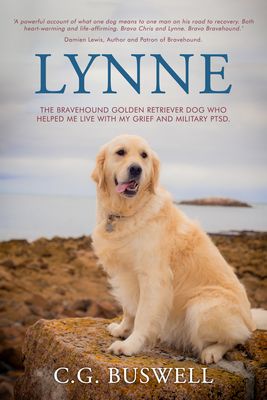
My PTSD assistance dog, Lynne, and I have written a book about how she helps me with my military Post Traumatic Stress Disorder, anxiety, and depression. I talk about my time in the QAs and the coping strategies I now use to be in my best health.
Along the way, I have had help from various military charities, such as Help for Heroes and The Not Forgotten Association and royalties from this book will go to them and other charities like Bravehound, who paired me with my four-legged best friend.
I talk openly about the death of my son by suicide and the help I got from psychotherapy and counselling and grief charities like The Compassionate Friends.
The author, Damien Lewis, said of Lynne:
"A powerful account of what one dog means to one man on his road to recovery. Both heart-warming and life-affirming. Bravo Chris and Lynne. Bravo Bravehound."
Download.
Buy the Paperback.
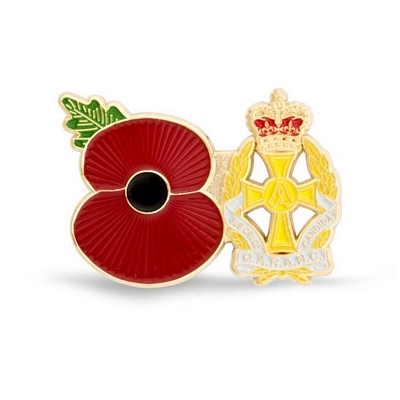
This beautiful QARANC Poppy Pin Badge is available from the Royal British Legion Poppy Shop.
For those searching military records, for information on a former nurse of the QAIMNS, QARANC, Royal Red Cross, VAD and other nursing organisations or other military Corps and Regiments, please try Genes Reunited where you can search for ancestors from military records, census, birth, marriages and death certificates as well as over 673 million family trees. At GenesReunited it is free to build your family tree online and is one of the quickest and easiest ways to discover your family history and accessing army service records.
More Information.
Another genealogy website which gives you access to military records and allows you to build a family tree is Find My Past which has a free trial.

Former Royal Air Force Regiment Gunner Jason Harper witnesses a foreign jet fly over his Aberdeenshire home. It is spilling a strange yellow smoke. Minutes later, his wife, Pippa, telephones him, shouting that she needs him. They then get cut off. He sets straight out, unprepared for the nightmare that unfolds during his journey. Everyone seems to want to kill him.
Along the way, he pairs up with fellow survivor Imogen. But she enjoys killing the living dead far too much. Will she kill Jason in her blood thirst? Or will she hinder his journey through this zombie filled dystopian landscape to find his pregnant wife?
The Fence is the first in this series of post-apocalyptic military survival thrillers from the torturous mind of former British army nurse, now horror and science fiction novel writer, C.G. Buswell.
Download Now.
Buy the Paperback.
If you would like to contribute to this page, suggest changes or inclusions to this website or would like to send me a photograph then please e-mail me.
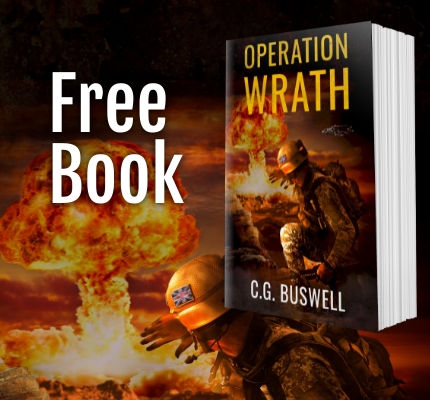
Free Book.
The death of the Brotherhood will be avenged.
RAF gunner Jason Harper and a team of Special Air Service operators are enraged after the death of their brothers by a terrorist drone strike. They fly into south-eastern Yemen on a Black-op mission to gather intelligence and avenge the death of their comrades.
Can they infiltrate the Al-Queda insurgents' camp, stay undetected, and call down their own drone missile strike and get home safely?
Will they all survive to fight another day?
Operation Wrath is a free, fast-paced adventure prequel to the non-stop action The Fence series by military veteran author C.G. Buswell.
Download for free on any device and read today.
This website is not affiliated or endorsed by The Queen Alexandra's Royal Army Nursing Corps (QARANC) or the Ministry of Defence.

